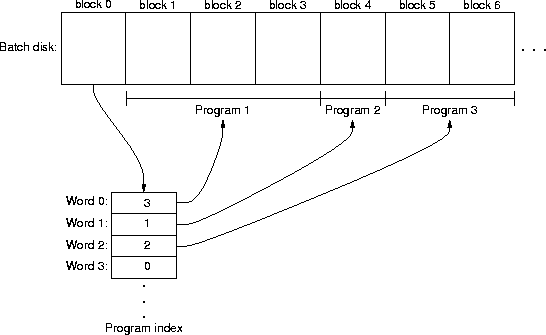Programming Assignment 1 - Process Management
Operating Systems, Fall 2000
Table of Contents
Due Date
This assignment is due on Wednesday, 11 October, no later than 2:00 p.m.
Introduction
This assignment implements a simple batch-oriented operating system, which
behaves as follows:
- After the operating system boots up, it reads programs from the
batch disk and executes them.
- The operating system supports multiprocessing; that is, whenever
possible, there may be more than one program executing at the same time.
- When all programs have been read and executed, the operating system
terminates.
For simplicity, you may assume the programs are to be run in the order they're
read from the batch disk. That is, it is not required that the operating
system scan the batch disk with the idea of packing primary storage with as
many programs as possible; first-come, first-serve scheduling is good enough
for this assignment.
The operating system should execute as many programs as possible. In
particular, if one program fails due to some error condition, the operating
system should throw it out and read the next program. Under no circumstances
should a failing program cause the operating system itself to fail.
The Batch Disk
A
batch disk is a disk containing a set of programs to be run. The
first block (block 0) of a batch disk is the
program index; the program
index gives the list of programs to be run. If a batch disk contains n
program, the program index for the batch disk has the following structure:
| word 0: | size1 | |
| word 1: | size2 | |
| . . . | . . . | |
| word n - 1: | sizen | |
| word n: | 0 | |
The value sizej gives the size of the j-th program in disk blocks;
sizej will always be greater than zero. The program-index list always
ends in zero, which means that 0 <= n < disk_block_size, where
n is the number of programs in the batch disk.
Programs occupy consecutive disk blocks starting with disk-block 1, the block
following the program-index block. A program always occupies a positive number
of blocks, and each program follows the next with no wasted disk blocks between
them.
For example, this diagram

shows a batch disk containing three programs. The first program has size 3;
that is, the first program occupies three disk blocks. The second program has
size 1 and the third program has size 2.
Loading Programs for Execution
A program is laid out on disk as a sequence of disk blocks. The order of the
program's contents on disk must be preserved in primary storage when a program
is loaded into primary storage for execution. The program's disk-block
contents must not be re-arranged in primary storage, and all the program's disk
blocks must be read into primary storage before the program can be run.
The program is loaded in primary storage in increasing address order. The
contents of the program's first disk block is loaded into primary storage
starting at location i; the contents of the program's second disk block is
loaded into primary storage starting at location i + disk_block_size;
and so on.
Once loaded into primary storage, the program's first instruction has address
i, the address of the first word of the program. The program counter
should be set to i when the program first executes.
System Calls
The test programs your operating system will execute make two system calls:
sleep and exit; part of this assignment is to implement these system calls.
These are the first two of many system calls you will be implementing in these
assignments, so you might want to give some though to designing an easily
changeable system-call implementation (or, you have to be willing to throw-away
and rewrite your system-call implementation several times, which is probably
the better approach to take anyway).
Interrupt Handlers
You will need to implement four interrupt handlers for this assignment: the
reboot interrupt handler, the disk interrupt handler, the countdown interrupt
handler, and the system-call interrupt handler. The reboot interrupt handler
installs your operating system in the hardware; the disk interrupt handler
takes care of interrupts from the disk; the countdown interrupt handler deals
with clock interrupts; and the system-call interrupt handles system calls from
the executing process. As with system calls, you'll be implementing and
re-implementing several other interrupt handlers in later assignments, so some
thought now may save you some pain later.
Test Batch Disks
There are two batch disks available you can use to test your operating system.
The first batch disk, pa1-nosleep.dsk, contains programs that call only
the exit system call. The second batch disk, pa1.dsk, contains programs
that call both the exit and sleep system calls. As a general plan of attack,
you could get your system working with pa1-nosleep.dsk and then move on to
get it working with pa1.dsk.
I will eventually make the assembler and loader I use to create the batch disk
available so you can create your own test disks. If enough people clamor for
them, I'll make them available sooner rather than later.
This page last modified on 2 October 2000.
